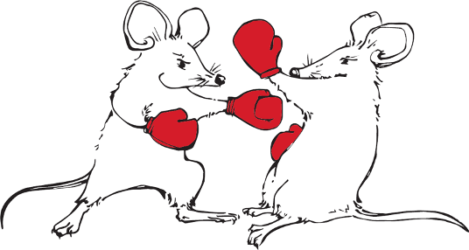By Skyler Jackman

Drawing by Jasmine Vazquez
The cerebellum is a small part of your brain, but it contains more than half of your neurons. For decades the cerebellum was mainly associated with its role in balance and motor coordination. However, growing evidence suggests the cerebellum plays wider roles in brain function. Patients with cerebellar damage often show cognitive and emotional deficits, and cerebellar pathology is strongly correlated with autism and post-traumatic stress disorder. This has renewed interest in the cerebellum’s role in non-motor function.
One intriguing hypothesis is that the cerebellum regulates aggression. At the beginning of the 20th century, the Italian physiologist Giuseppe Pagano obtained the Amazonian dart poison curare, and used this neurotoxin to silence different regions of the cerebellum in dogs. Injecting curare into most regions caused motor dysfunction. But in a central region called the vermis, curare caused the animal “to become suddenly furious… struggling to bite who knows how many phantoms of its agitated psyche.” Pagano’s anecdotal observations were eventually bolstered by experiments on humans, cats, and monkeys, which reported changes in aggression caused by electrically stimulating, or surgically removing, the vermis. However, these anecdotal (and often conflicting) results did not clarify which cerebellar neurons regulate aggression.
To understand which neurons in the cerebellum influence aggression, we turned to genetically-modified mice that allow us to manipulate specific neurons, and “optogenetic” light-sensitive proteins that allow neuroscientists to quickly turn neuronal activity on or off with light. We expressed these optogenetic proteins in Purkinje cells, a type of neuron that relays all information from cerebellum to other brain regions. We then used light to activate, or silence, different clusters of Purkinje cells.
Important for our study, mice are surprisingly aggressive. Males are territorial and attack other males that enter their home environment. This form of aggression has been studied for decades using the “resident-intruder” assay, where a male intruder is introduced into a resident male’s cage. When we used light to activate Purkinje cells in the vermis, we found that resident mice decreased their rate of attacks within seconds. Silencing Purkinje cells had the opposite effect, making mice more prone to attack. These effects were specific to the vermis, as manipulating Purkinje cells in another region of the cerebellum did not change mouse aggression. Our results provide strong evidence that the cerebellum regulates aggression, and suggest that genetically-tractable mice can be used to better define the neurons and activity patterns that modulate aggression.
This study was supported by the GVR Khodadad Research Fund for the Study of Excessive (Pathological) Selfishness and Aggressive Behavior.
Skyler Jackman was formerly a postdoc in the lab of Wade Regehr and is currently an Assistant Scientist at Oregon Health & Science University.
Learn more in the original research article:
Cerebellar Purkinje cell activity modulates aggressive behavior. Jackman SL, Chen CH, Offermann HL, Drew IR, Harrison BM, Bowman AM, Flick KM, Flaquer I, Regehr WG. Elife. 2020 Apr 28.
This story will also appear in the HMS Neurobiology Department newsletter, The Action Potential.
News Types: Community Stories
